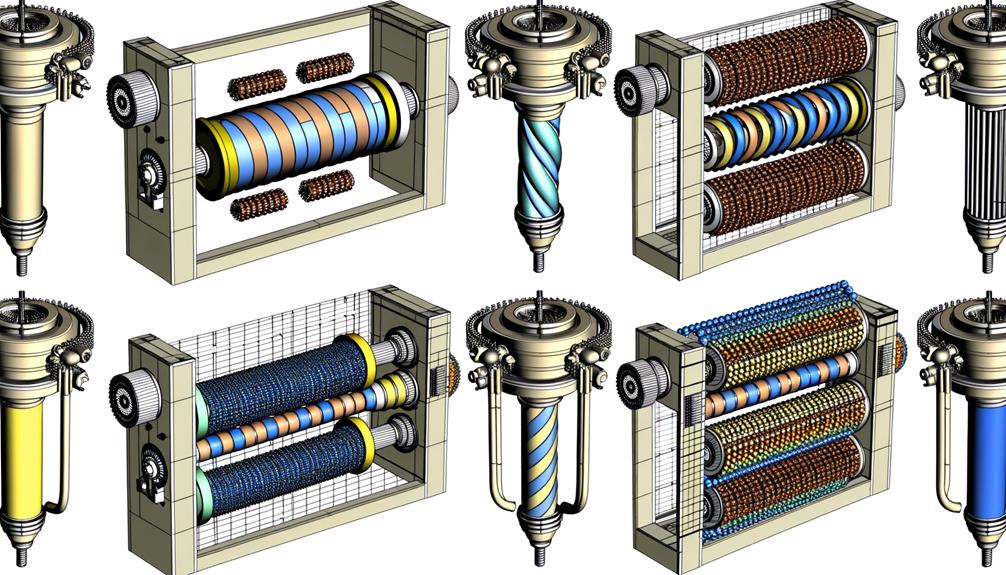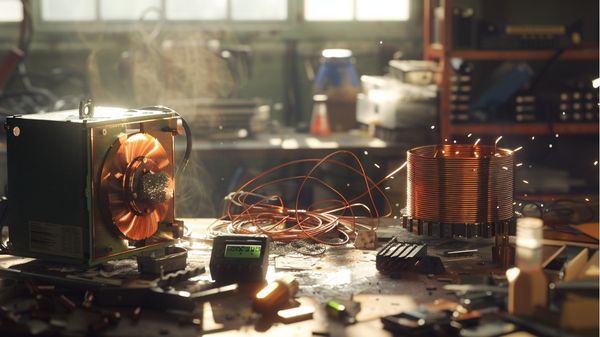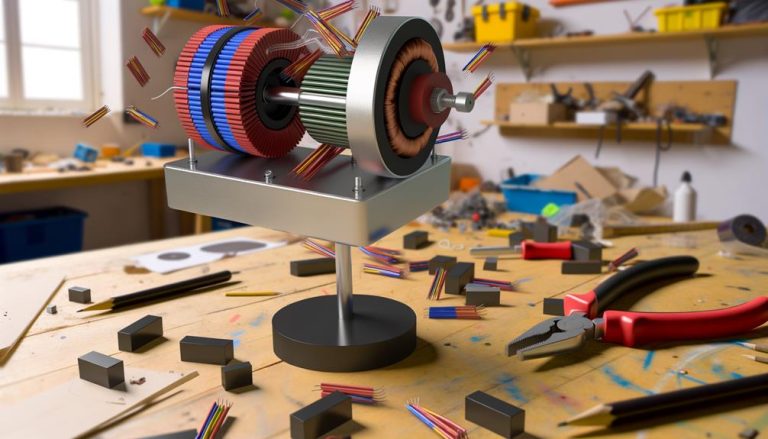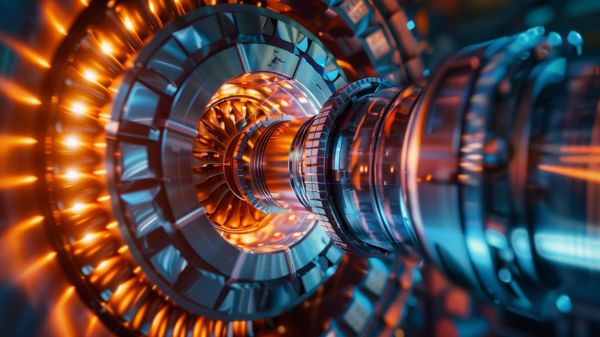In examining the mechanics of a magnet-powered electric generator, it’s essential to understand the role of electromagnetic induction, a phenomenon where a change in magnetic field within a coil of wire produces an electric current. The heart of this system lies in its ability to harness the kinetic energy of rotating magnets, which is then transforms into usable electrical power.
This process not only underscores the principles laid out by Michael Faraday but also highlights the seamless conversion of mechanical to electrical energy. As we explore further, it becomes apparent that the implications of these generators extend beyond their technical specifications, influencing energy sustainability and efficiency in profound ways.

Key Takeaways
- A magnet-powered electric generator uses electromagnetic induction to convert mechanical energy into electrical energy.
- Rotating magnets within the rotor create a dynamic magnetic field that interacts with wire coils in the stator.
- Changes in the magnetic field induce electromotive force (EMF) in the coils due to Faraday’s Law of electromagnetic induction.
- The induced EMF generates an electric current, which is then harnessed as usable electricity.
- Permanent magnets, typically made of neodymium, are essential for providing a stable, strong magnetic field necessary for efficient energy conversion.
Principles of Electromagnetic Induction
Electromagnetic induction, a phenomenon articulated by Michael Faraday, is pivotal in converting mechanical energy into electrical energy. This process involves the movement of a conductor, such as a wire, through a magnetic field. The movement varies the magnetic flux—the total magnetic field passing through a particular area in a specified direction—throughout the conductor.
According to Faraday’s Law of Electromagnetic Induction, this change in magnetic flux over time induces an electromotive force (EMF) or voltage in the conductor.
The essence of electromagnetic induction lies in its ability to produce voltage as a response to changing magnetic environments. The faster the magnetic flux changes, either by altering the speed of the conductor’s movement or the strength of the magnetic field, the greater the induced voltage.
This principle is fundamental in electrical generators where mechanical motion—such as the kinetic energy from wind or flowing water—is transformed into electrical energy, showcasing a direct conversion of energy types through induction.
This transformation not only underscores the versatility and efficiency of electromagnetic induction but also supports the liberation of energy resources from traditional, often environmentally hazardous methods to more sustainable, innovative solutions.
Components of Magnet Generators
Magnet generators, integral to the production of electrical energy, comprise two main components: the rotor and the stator. The rotor is designed with permanent magnets, typically made from high-performance materials like neodymium-boron-iron. These magnets are essential for generating a strong, stable magnetic field.
The stator, on the other hand, contains wire coils that are strategically positioned to capture the magnetic forces exerted by the rotor. This interaction induces voltage in the coils through electromagnetic induction, a process vital for converting mechanical energy into electrical energy.
Here is a breakdown of the components and their roles:
| Component | Function |
|---|---|
| Rotor | Houses permanent magnets and rotates to create a magnetic field. |
| Stator | Contains coils that receive the magnetic field to generate electricity. |
| Magnets | Made from materials like neodymium to guarantee a strong magnetic field. |
| Coils | Capture the magnetic forces to induce voltage and produce electrical energy. |
This design not only facilitates efficient energy conversion but also enhances the generator’s reliability and reduces maintenance needs, making it ideal for renewable energy applications like wind turbines. The compact construction enhances portability and eases installation, essential for liberation in energy production.
Types of Magnet-Powered Generators
In the domain of magnet-powered generators, the design plays an essential role in dictating the efficiency and output of the device.
Varieties such as Axial and Radial Permanent Magnet Generators leverage different orientations of magnetic flux to optimize performance for specific applications, ranging from industrial machinery to renewable energy systems.
Understanding these configurations is vital for selecting the appropriate generator type to achieve desired energy efficacy and operational reliability in practical scenarios.
Generator Design Varieties
Several varieties of magnet-powered generators are used in modern engineering, each distinguished by its unique design and operational characteristics.
These designs cater to specific applications and efficiency demands, aligning with the evolving needs of both industry and renewable energy sectors. The ability to choose from various generator design varieties enhances the adaptability of electric generators in different environmental and operational conditions.
- Axial Flux Permanent Magnet Generators (AF PMGs): These generators are famous for their compact frame and superior power-to-weight ratio. They operate with a magnetic flux parallel to the axis, reducing noise and vibration due to less core material use.
- Radial Flux Permanent Magnet Generators: Aligning the magnetic flux with rotor rotation, these are reminiscent of traditional motors and are famous for their ease of integration and robustness in conventional setups.
- Induction Generators: Particularly effective in applications like small hydro plants, they rely on a stable network to induce current in the rotor, making them reliable and straightforward for energy conversion.
- Inductor Alternators: These are optimized for high-frequency applications, generating voltage through flux pulsations and are highly reliable due to their non-reliant nature on electrical rotor connections.
Each type serves distinct segments, highlighting the diversity and innovation within the field of electric generators and induction generators.
Efficiency and Output
Understanding the efficiency and output of various types of magnet-powered generators is essential for selecting the appropriate technology for specific applications. Permanent-magnet generators (PMG), for instance, are favorable for their high efficiency. They eliminate the need for external power sources to energize the magnetic field, leading to a more compact and economical design.
This inherent efficiency of PMGs is largely due to the use of high-flux density materials such as neodymium-boron-iron, which offer significant advantages in size and performance over traditional ferrite magnets.
Further exploring the domain of efficiency, axial permanent magnet generators exemplify advancements in minimizing material use while maximizing power output. Their design reduces noise and vibration, enhancing operational smoothness and extending lifespan.
In contrast, induction generators, commonly used in renewable energy setups like small hydroelectric plants, optimize output by adjusting to the rotor speed difference from synchronous speed. This feature allows them to adapt efficiently under fluctuating load conditions.
The overall output and performance of these generators are also heavily influenced by the design intricacies of the rotor and stator. Optimized configurations in these components are vital for enhancing energy conversion rates and minimizing operational losses, thereby ensuring maximum efficiency and output in real-world applications.
Common Usage Examples
Among various applications, permanent magnet generators (PMGs) are prominently used in wind turbines to transform mechanical energy derived from wind into electrical energy, all without the need for external excitation currents. This direct energy conversion enhances efficiency and sustainability, making PMGs a cornerstone in renewable energy technologies.
Further illustrating the versatility of magnetic generators, consider these examples:
- Axial Flux Permanent Magnet Generators (AF PMGs): These are very famous in compact settings such as electric vehicles and portable power systems. Their high power-to-weight ratio and reduced core material make them ideal for applications demanding efficiency and portability.
- Radial Flux Permanent Magnet Generators: Commonly used in both AC and DC motor configurations, these generators are integral to various industrial machinery, offering ease of installation and reliable operation across diverse operational conditions.
- Electric Bicycles and Scooters: In these applications, magnetic generators convert kinetic energy from pedaling or motion into electrical energy, effectively assisting propulsion and enhancing the riding experience.
- Small Hydroelectric Installations: Here, induction generators capable of handling variable speeds are employed, capitalizing on fluctuating water flow rates to guarantee consistent and adaptive power output.
Each of these applications underscores the critical role of permanent magnet generators in modern energy conversion scenarios.
Generating Electricity With Magnets
In the context of magnet-powered electric generators, the principles of magnet interaction and the energy conversion process are central to understanding how electricity is generated.
The interaction between the permanent magnets and the conductive coils harnesses electromagnetic induction, whereby a change in magnetic flux across the coils induces an electromotive force.
This force, in turn, drives the flow of electrons, thereby converting mechanical motion into usable electrical energy efficiently.
Magnet Interaction Principles
Through the principles of electromagnetic induction, a magnet powered electric generator harnesses the power of magnetic fields to produce electricity. The core mechanism of this process involves the interaction of magnetic fields with conductive materials to facilitate the conversion of mechanical energy into electrical energy. Here, the magnetic flux plays a vital role.
Key aspects of magnet interaction in these generators include:
- Magnetic Flux Dynamics: The rate of change in magnetic flux directly influences the voltage induced in the generator. Rapid changes in the magnetic environment are necessary for effective electrical generation.
- Material Efficacy: Using high-quality permanent magnets like neodymium enhances the consistency and strength of the magnetic field, which is essential for sustained electricity generation.
- Design Efficiency: The geometric and material design of the rotor and stator impacts how effectively they interact. This interaction is significant for optimizing the conversion process.
- Conductor Movement: The relative motion between the magnetic field and the conductive coils in the stator is fundamental. It is this movement that triggers electromagnetic induction, turning energy into electrical energy.
These principles guarantee that a magnet powered electric generator not only functions reliably but does so with a focus on maximizing energy conversion efficiency.
Energy Conversion Process
A magnet powered electric generator leverages the principle of electromagnetic induction to transform mechanical motion into electrical energy. This energy conversion process begins when mechanical energy, typically harnessed from a rotating turbine or similar prime mover, initiates the movement of a rotor equipped with high-strength neodymium magnets.
As these magnets spin, they create a dynamic magnetic field that traverses through the nearby coils of wire integrated into the stator. According to Faraday’s Law of electromagnetic induction, the electromotive force (EMF) induced in these coils is directly proportional to the rate of change of the magnetic flux.
Consequently, the faster the magnets move relative to the coils, the greater the induced voltage, and therefore, the greater the electricity generated. This method of generating electricity does not require external power supplies, making it an inherently sustainable approach to energy production.
The design and materials used, such as the neodymium magnets, are critical for maximizing the efficiency of the generator. These magnets are favored for their ability to produce a strong magnetic field, which greatly enhances the efficiency of the energy conversion process, leading to more effective electricity generation with potentially lower resource expenditure.
Applications of Magnet Generators
Magnet generators, essential in modern energy solutions, find extensive application across various sectors due to their efficiency and reliability. These generators are particularly transformative in the field of renewable energy, where they considerably contribute to sustainable practices.
- Renewable Energy Systems: In wind turbines, magnet generators play an important role by converting kinetic energy from the wind into electrical energy without requiring fossil fuel inputs, thereby enhancing the eco-friendliness of energy sources.
- Backup Power Systems: They guarantee a continuous power supply in critical situations such as power outages, making them indispensable in hospitals, data centers, and other significant facilities, due to their reliability and operational efficiency.
- Electric Vehicles: Integration in electric vehicles helps in improving energy efficiency and overall vehicle performance, pushing forward the limits of what is possible in eco-friendly transportation.
- Hydroelectric Installations: Small-scale hydroelectric projects benefit from magnet generators as they efficiently harness the power of flowing water, contributing to localized energy solutions that reduce dependency on large-scale grid systems.
These applications underline the versatility and fundamental importance of magnet generators in advancing energy management and efficiency within an increasingly energy-conscious world.
Advantages of Using Magnet Generators
Several compelling advantages make magnet generators a preferred choice in various industries, particularly those focusing on sustainable and efficient energy solutions. Utilizing permanent magnets, these generators create a stable magnetic field without the need for external DC excitation currents.
This inherent stability not only enhances reliability but also greatly improves efficiency in energy conversion. Traditional generators, which rely on electromagnets, often suffer from higher energy losses, making magnet generators a superior alternative.
The design of magnet generators eliminates moving electrical connections to the rotor. This reduction in mechanical complexity decreases the frequency and cost of maintenance, while simultaneously extending the lifespan of the generator. Such characteristics are highly beneficial in reducing operational downtimes and ensuring continuous power supply.
Moreover, magnet generators are adept at functioning in diverse environmental conditions, making them exceptionally suitable for renewable energy systems like wind and hydroelectric power. Their compact size and versatility in installation underscore their utility in small-scale, off-grid, or remote power generation scenarios.
These attributes not only cater to the growing demand for renewable energy solutions but also empower communities by providing reliable and efficient energy access, fostering energy independence and sustainability.
Conclusion
In summary, a magnet-powered electric generator harnesses the principles of electromagnetic induction to convert mechanical energy into electrical energy efficiently. This generator, integral to renewable energy technologies, utilizes the dynamic interaction between rotating magnets and wire coils to induce electromotive force.
The flexibility in types and configurations of these generators allows for broad applications, from small-scale installations to large industrial projects, offering significant advantages in sustainability and energy independence. If you’re interested and want to learn more about a magnetic powered generator and want to build it yourself then I highly recommend you check out the complete blueprint below.





